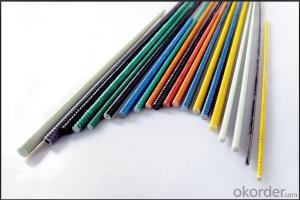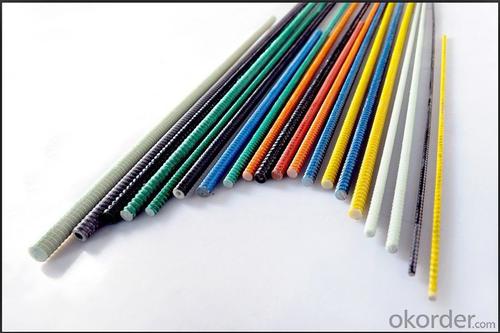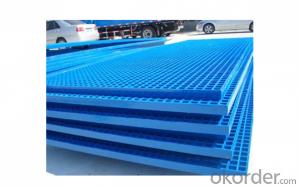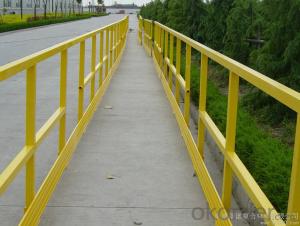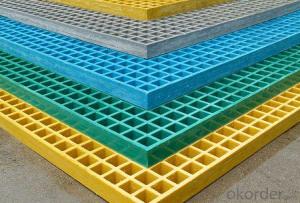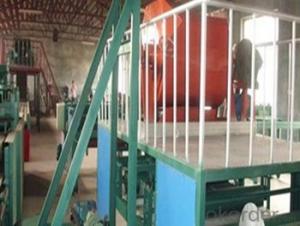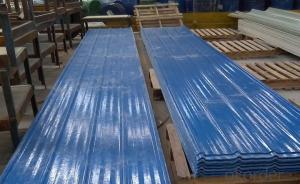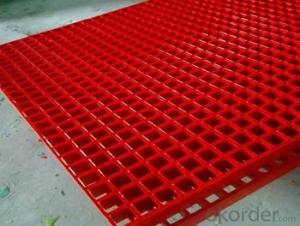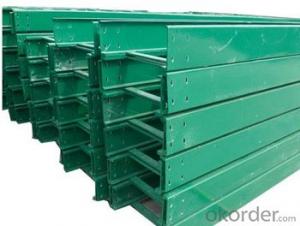FRP Pultrusion Profiles:FRP Rods and FRP Tubes Made in China
- Loading Port:
- Shanghai
- Payment Terms:
- TT OR LC
- Min Order Qty:
- 0 mm
- Supply Capability:
- 20000 mm/month
OKorder Service Pledge
OKorder Financial Service
You Might Also Like
Description of FRP Rods and Tubes
FRP rods and tubes are manufantured by high-strength fiberglass as reinforcing material. thermosetting resin as the base, and then taken shape on a special pultruded mold, where the high temperature activates the resin to cure.
Main Features of FRP Rods and Tubes
light weight and high strength, anti-ageing, aesthetically pleasing appearance, environmental friendliness
Specifications of FRP Rods and Tubes
| Normal size | Φ32*Φ26,Φ32*Φ27.5,Φ32*Φ28,Φ32*Φ22,Φ31*Φ25,Φ30*Φ26,Φ30*Φ24,Φ28*Φ24,Φ28*Φ22,Φ25,.4*Φ20.5,Φ25.4*Φ18.4,Φ24*Φ20,Φ22*Φ18.4 |
| Surface effect | nexus mat surface, continuous strand mat surface, stitched mat surface, painting surface, wood texture surface |
| Regular Color | yellow, red, blue, green, white, gary |
Applications of FRP Rods and Tubes
1.farming tool, shovel, hoe, pickaxe, ax, hammer etc.
2.gardening tool, grass shears, tree pruner, fencing shears, grass harrow etc.
3.cleaning tool, mop, broom, window brush etc.
IMages of FRP Rods and Tubes
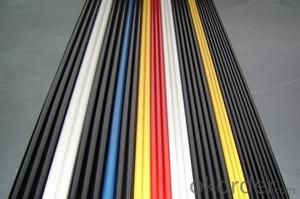
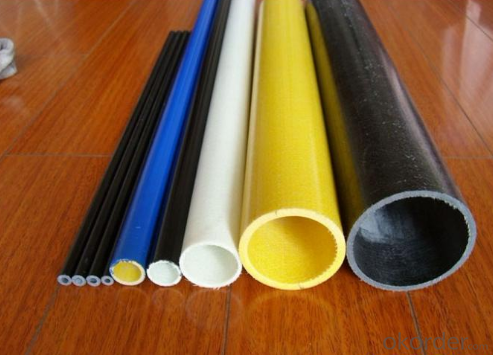
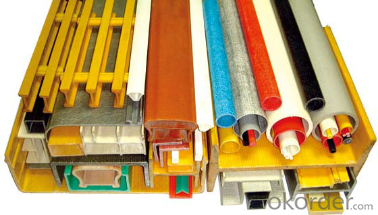
FAQ
1. How about the documents after shipment?
After shipment, we ll send all original documents to you by DHL, including Packing List.Commercial Invoice, B/L, and other certificates as required by clients.
2. How long is the delivery time?
Usually it takes 10-25days after receipt of the deposits or L/C, and it also depends on the quantity of your order.
3. How's the payment?
Telegraphic Transfer(T/T) or Letter of Credit(L/C)
4. Do You Arrange Shipment?
Yes, dear esteemed customers, for FOB or CIF price, we will arrange shipment for you. For EXW price, clients need to arrange shipment by themselves or their agents.
5. How is the package?
Usually, we arrange the standard out-package for exporting.
- Q: Are FRP pultrusion profiles resistant to chemicals used in oil refineries?
- Yes, FRP pultrusion profiles are highly resistant to chemicals used in oil refineries. The combination of their fiberglass reinforcement and resin matrix makes them impervious to many corrosive substances, ensuring long-term durability and performance in such harsh environments.
- Q: What is the cost of FRP pultrusion profiles compared to other materials?
- The cost of FRP pultrusion profiles is generally lower compared to other materials such as steel or aluminum. This is due to the relatively low cost of raw materials used in the manufacturing process, as well as the efficiency and speed of the pultrusion production method. Additionally, the long lifespan and low maintenance requirements of FRP pultrusion profiles make them a cost-effective choice in the long run.
- Q: Can FRP pultrusion profiles be used in cooling towers?
- Yes, FRP (Fiber Reinforced Polymer) pultrusion profiles can be used in cooling towers. FRP pultrusion profiles offer several advantages that make them suitable for cooling tower applications. Firstly, FRP pultrusion profiles have excellent corrosion resistance, which is essential in a cooling tower environment where exposure to water and chemicals is common. Unlike traditional materials like steel, FRP pultrusion profiles do not rust or corrode, ensuring longer service life and reduced maintenance costs. Secondly, FRP pultrusion profiles have high strength-to-weight ratio, making them lightweight yet strong enough to withstand the structural requirements of cooling towers. This allows for easier installation and transportation, reducing overall project costs. Thirdly, FRP pultrusion profiles have excellent thermal insulation properties. Cooling towers involve the transfer of heat from water to the surrounding air, and the thermal insulation provided by FRP pultrusion profiles helps enhance the efficiency of the cooling process. Lastly, FRP pultrusion profiles are highly customizable and can be designed to meet specific requirements of cooling tower applications. They can be engineered to have various shapes, sizes, and dimensions to fit the specific needs of the cooling tower design. Overall, FRP pultrusion profiles are a reliable and cost-effective choice for cooling tower applications, offering corrosion resistance, high strength-to-weight ratio, thermal insulation, and customization options.
- Q: Can FRP pultrusion profiles be used in the construction of wind turbine blades?
- Indeed, FRP pultrusion profiles have the capability to be utilized in the construction of wind turbine blades. There are several advantages offered by FRP pultrusion profiles that render them suitable for this purpose. To begin with, FRP pultrusion profiles possess a lightweight yet robust nature, a crucial characteristic for wind turbine blades since they must endure the aerodynamic forces exerted by the wind. The high strength-to-weight ratio of FRP pultrusion profiles permits the creation of longer and more effective blades. Moreover, FRP pultrusion profiles exhibit exceptional corrosion resistance properties, a vital attribute for wind turbines that are exposed to harsh weather conditions. In contrast to traditional materials like steel, FRP does not corrode, thereby ensuring an extended service life for the wind turbine blades. Additionally, FRP pultrusion profiles are customizable to satisfy specific design requirements. This flexibility allows for the optimization of blade performance by tailoring the shape, thickness, and stiffness of the profiles to maximize energy capture and minimize fatigue. Furthermore, FRP pultrusion profiles possess good fatigue resistance, enabling them to endure repeated loading cycles without experiencing significant performance degradation. This is particularly crucial for wind turbine blades, which encounter cyclic loading due to wind gusts and changes in wind direction. Lastly, FRP pultrusion profiles are electrically non-conductive, a beneficial trait for wind turbine blades as it eliminates the risk of electrical discharge during operation. In conclusion, the lightweight, strong, corrosion-resistant, and customizable nature of FRP pultrusion profiles makes them an outstanding choice for the construction of wind turbine blades. This contributes to the advancement of more efficient and durable wind energy systems.
- Q: Can FRP pultrusion profiles be used in pedestrian bridges?
- Yes, FRP pultrusion profiles can be used in pedestrian bridges. FRP pultrusion profiles offer a number of advantages that make them suitable for bridge construction, including their high strength-to-weight ratio, corrosion resistance, and durability. These profiles are made by pulling continuous fibers through a resin bath and then through a heated die, resulting in a strong and lightweight material. The lightweight nature of FRP pultrusion profiles makes them ideal for pedestrian bridges as they can be easily transported and installed. Additionally, their high strength allows them to withstand the load requirements of pedestrian traffic. These profiles also have excellent resistance to corrosion, which is especially important for bridges that are exposed to environmental elements such as rain, humidity, and saltwater. Furthermore, FRP pultrusion profiles are highly durable and require minimal maintenance compared to traditional construction materials like steel or concrete. They are not susceptible to rust or rot, and their non-conductive properties make them safe for use in areas with electrical infrastructure. In summary, FRP pultrusion profiles are a suitable choice for pedestrian bridges due to their lightweight, high strength, corrosion resistance, and durability. These profiles offer a cost-effective and long-lasting solution for bridge construction, ensuring the safety and convenience of pedestrians.
- Q: Can FRP pultrusion profiles be used in the construction of railway platforms?
- Yes, FRP (Fiber Reinforced Polymer) pultrusion profiles can be used in the construction of railway platforms. FRP pultruded profiles offer several advantages that make them suitable for this application. Firstly, FRP pultrusion profiles are lightweight yet highly durable. This makes them ideal for railway platforms as they can withstand heavy loads and frequent foot traffic without experiencing significant deformation or degradation over time. Secondly, FRP pultruded profiles have excellent corrosion resistance. This is particularly important for railway platforms, which are often exposed to harsh environmental conditions, including rain, snow, and salt. Unlike traditional materials such as steel or wood, FRP does not rust or rot, ensuring a longer lifespan for the platform. Additionally, FRP pultrusion profiles offer design flexibility. They can be customized to meet specific dimensional and structural requirements, allowing for the creation of platforms of various shapes and sizes. This versatility is beneficial for railway platforms, as they often need to be tailored to fit the available space and accommodate specific railway configurations. Furthermore, FRP pultrusion profiles have good electrical insulation properties. This is important for railway platforms, as they need to be electrically isolated from the tracks to prevent electrical shocks and ensure passenger safety. Lastly, FRP pultrusion profiles are easy to install and require minimal maintenance. They can be prefabricated off-site and quickly assembled on-site, reducing construction time and costs. Moreover, FRP does not require regular painting or sealing, saving both time and money on maintenance. In conclusion, FRP pultrusion profiles are a viable option for the construction of railway platforms due to their lightweight, durability, corrosion resistance, design flexibility, electrical insulation properties, and ease of installation and maintenance.
- Q: Are FRP pultrusion profiles resistant to automotive fluids?
- Yes, FRP pultrusion profiles are generally resistant to automotive fluids. FRP stands for Fiber Reinforced Polymer, which is a composite material made up of a combination of fibers and a polymer matrix. The fibers used in FRP, such as fiberglass, carbon, or aramid, provide excellent resistance to many automotive fluids, including oils, fuels, and coolants. The polymer matrix used in FRP profiles is typically a thermosetting resin, such as polyester, vinyl ester, or epoxy. These resins are known for their chemical resistance properties, making FRP pultrusion profiles highly resistant to a wide range of automotive fluids. They can withstand exposure to various fluids without experiencing significant degradation or loss of mechanical properties. It is important to note that the specific resistance of FRP pultrusion profiles to automotive fluids may vary depending on the type of resin used and the specific composition of the composite material. Therefore, it is recommended to consult with the manufacturer or supplier of the FRP profiles to ensure they are suitable for the intended application and the specific automotive fluids they will be exposed to.
- Q: Can FRP pultrusion profiles be used in wastewater treatment facilities?
- Yes, FRP pultrusion profiles can be used in wastewater treatment facilities. FRP (Fiber Reinforced Plastic) pultrusion profiles are known for their high strength, corrosion resistance, and durability, making them suitable for various applications, including in harsh environments like wastewater treatment facilities. These profiles can be used for constructing structures, such as walkways, handrails, grating, and tanks, as well as for reinforcing or replacing traditional materials, such as steel or concrete, in different components of the facility. The corrosion resistance of FRP pultrusion profiles ensures their longevity and reduces maintenance costs, making them a viable option for wastewater treatment facilities.
- Q: What are the different surface finishes available for FRP pultrusion profiles?
- FRP pultrusion profiles offer several options for surface finishes that aim to improve the appearance, durability, and practicality of the profiles. 1. Smooth Finish: The smooth and glossy surface of this basic finish option creates a polished and clean appearance, which is ideal for applications requiring a sleek and professional look. 2. Textured Finish: Adding texture to the profile surface enhances grip and slip resistance, making it suitable for walkways, stairs, and ramps that require improved traction. 3. Anti-Skid Finish: Similar to the textured finish, anti-skid finishes provide superior slip resistance, making them ideal for areas exposed to wet or slippery conditions like marine environments, bridges, and industrial flooring. 4. UV Resistant Finish: Profiles exposed to outdoor environments can benefit from a UV resistant finish that safeguards against sunlight damage, preventing color fading, degradation, and loss of mechanical properties. 5. Fire Retardant Finish: Fire retardant finishes enhance the fire resistance of FRP profiles, making them essential in applications where fire safety is a concern, such as building construction, transportation, and electrical enclosures. 6. Colored Finish: FRP pultrusion profiles can be customized with colored finishes to match specific design or branding requirements, allowing for visual integration with the surrounding environment. It's important to note that the availability of these surface finishes may vary depending on the manufacturer and specific product. Consulting with an FRP pultrusion specialist or supplier can provide more detailed information on the available finishes and their suitability for various applications.
- Q: Are FRP pultrusion profiles resistant to seismic activity?
- FRP (Fiber Reinforced Polymer) pultrusion profiles are known for their high strength-to-weight ratio and excellent mechanical properties. However, when it comes to seismic activity, their resistance depends on various factors. In general, FRP pultrusion profiles can exhibit good resistance to seismic activity due to their inherent properties. The composite materials used in their construction, such as fiberglass and resin, offer high tensile strength and stiffness, making them capable of withstanding dynamic loads caused by earthquakes. Moreover, FRP pultrusion profiles have been extensively tested and proven to possess excellent fatigue resistance. This property is crucial during seismic events as structures are subjected to repeated dynamic loading. The ability of FRP profiles to withstand cyclic loading without suffering from fatigue failure significantly enhances their seismic resistance compared to traditional materials like steel or concrete. Another advantage of FRP pultrusion profiles in seismic activity is their lightweight nature. Their low weight reduces the overall mass of the structure, resulting in lower seismic forces. This weight reduction can lead to reduced seismic responses and less damage during an earthquake. However, it is important to note that the seismic resistance of FRP pultrusion profiles can be influenced by various factors. These include the design and quality of the profiles, the connection details, and the overall structural system in which they are used. Proper engineering and design considerations must be taken into account to ensure optimal performance and seismic resistance. In conclusion, FRP pultrusion profiles have the potential to offer good resistance to seismic activity due to their high strength, stiffness, and fatigue resistance. However, their performance in seismic events depends on various factors, and careful design and engineering practices are essential to maximize their seismic resistance.
Send your message to us
FRP Pultrusion Profiles:FRP Rods and FRP Tubes Made in China
- Loading Port:
- Shanghai
- Payment Terms:
- TT OR LC
- Min Order Qty:
- 0 mm
- Supply Capability:
- 20000 mm/month
OKorder Service Pledge
OKorder Financial Service
Similar products
Hot products
Hot Searches
Related keywords
